May ignites the night sky with wonders like the upcoming Flower Moon on May 12, a celestial ballet best appreciated through the lens of quality amateur telescopes. As the brilliant full moon wanes, the canvas above deepens, offering spectacular views of stars painted in diverse hues – from the cool blue-white shimmer of the Summer Triangle to the warm oranges of Arcturus and the fiery reds of Antares.
For those tracking planets, May presents a prime opportunity to observe Saturn gracing the pre-dawn hours, even posing alongside the crescent moon on the 22nd. Navigating the vast universe from your backyard is an exhilarating experience, and selecting the right instrument is the first step on this cosmic journey.
Embarking on the path of amateur astronomy can feel like venturing into uncharted territory, especially when faced with the myriad options available for amateur telescopes. Our comprehensive guide is crafted to demystify the selection process, catering to varying budgets, skill levels, and astronomical interests. Drawing on hands-on experience and expert insights, we evaluate recommended models based on their observational prowess, user-friendliness, and overall value. Choosing the perfect telescope means unlocking breathtaking views and deepening your connection with the cosmos, turning simple stargazing into a profound exploration.
The Quick List: Top Amateur Telescopes Recommended
Finding the ideal amateur telescope hinges on balancing performance, ease of use, and budget. Here’s a curated selection of instruments that stand out for amateur astronomers.
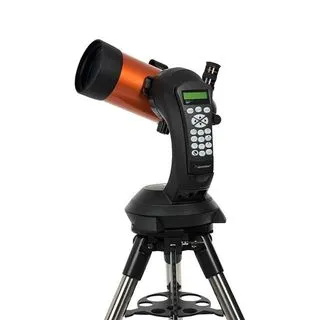 Celestron NexStar 4SE telescope on a white background
Celestron NexStar 4SE telescope on a white background
Celestron NexStar 4SE
Best introductory amateur telescope
An excellent starting point for beginners, this amateur telescope is simple to set up and operate, delivering clear, bright images complemented by helpful features. Read more below.
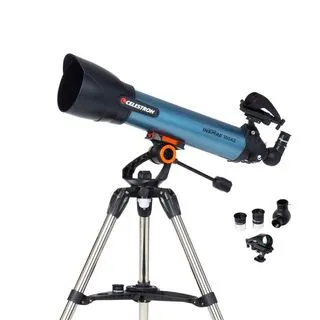 Celestron Inspire 100AZ telescope on a white backgroundBest budget telescopeCelestron Inspire 100AZ
Celestron Inspire 100AZ telescope on a white backgroundBest budget telescopeCelestron Inspire 100AZ
Best value amateur telescope
The Celestron Inspire 100AZ serves as a solid entry-level amateur telescope kit, well-suited for newcomers to astronomy and includes several useful accessories. Read more below.
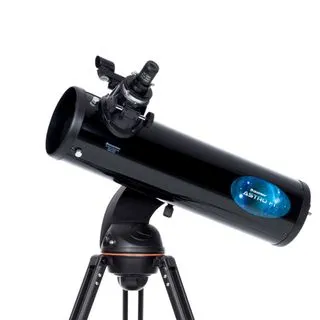 Celestron Astro Fi 130 telescope on a white backgroundBest value for enthusiastsCelestron Astro Fi 130
Celestron Astro Fi 130 telescope on a white backgroundBest value for enthusiastsCelestron Astro Fi 130
Recommended amateur telescope for enthusiasts on a budget
Our testing found the Celestron Astro Fi 130 to be an impressive amateur telescope offering substantial value for its price point. Read more below.
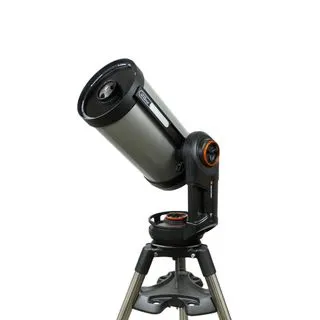 Celestron NexStar Evolution 9.25 telescope on a white backgroundBest premiumCelestron NexStar Evolution 9.25
Celestron NexStar Evolution 9.25 telescope on a white backgroundBest premiumCelestron NexStar Evolution 9.25
Top-tier amateur telescope for experienced stargazers
This is an exceptional amateur telescope praised for its easy setup and stunning observational capabilities, suitable even for seasoned amateur astronomers. Read more below.
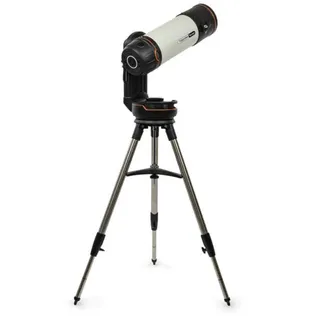 Celestron Origin on a tripod on a white backgroundBest for astroCelestron Origin Intelligent Home Observatory
Celestron Origin on a tripod on a white backgroundBest for astroCelestron Origin Intelligent Home Observatory
Best smart amateur telescope for astrophotography
This innovative smart telescope allows for capturing beautiful deep-sky images rapidly, although it’s specialized and not a general-purpose amateur telescope. Read more below.
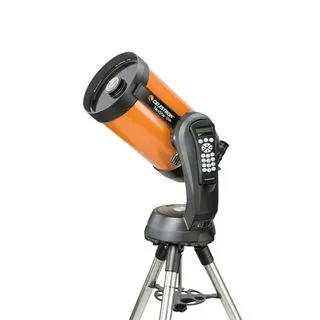 Celestron NexStar 8SE telescope on a white backgroundBest motorized telescopeCelestron NexStar 8SE
Celestron NexStar 8SE telescope on a white backgroundBest motorized telescopeCelestron NexStar 8SE
Highly recommended motorized amateur telescope
An outstanding choice for amateur astronomers of all levels, this amateur telescope is remarkably easy to use yet powerful enough for observing distant celestial objects and trying astrophotography. Read more below.
Load the next 5 products ↴
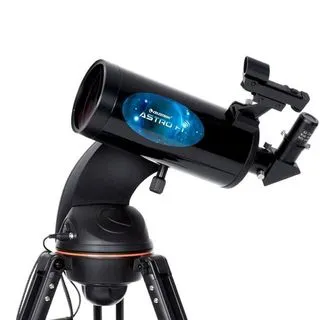 Celestron Astro Fi 102 telescope on a white backgroundBest for portabilityCelestron Astro Fi 102
Celestron Astro Fi 102 telescope on a white backgroundBest for portabilityCelestron Astro Fi 102
Most portable amateur telescope
If you’re an amateur astronomer facing significant urban light pollution and need an easily transportable telescope for trips to darker locations, this model is an excellent candidate. Read more below.
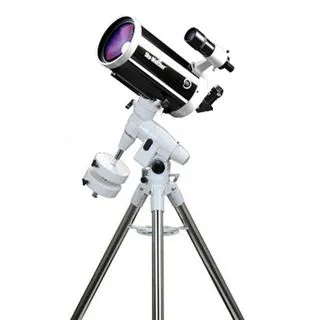 Sky-Watcher Skymax 150 PRO on a white backgroundBest for accessoriesSky-Watcher Skymax 150 PRO
Sky-Watcher Skymax 150 PRO on a white backgroundBest for accessoriesSky-Watcher Skymax 150 PRO
Amateur telescope with excellent accessory options
This amateur telescope excels at capturing various cosmic subjects, from nebulae to galaxies. It boasts superb optical clarity and is highly adaptable for additional accessories, making it a versatile choice for the dedicated amateur astronomer. Read more below.
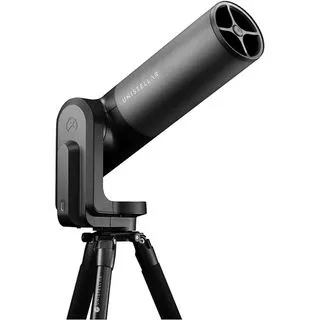 Unistellar eQuinox 2 Smart TelescopeBest smart telescopeUnistellar Equinox 2
Unistellar eQuinox 2 Smart TelescopeBest smart telescopeUnistellar Equinox 2
Premium smart amateur telescope
For amateur astronomers with a generous budget, the Unistellar Equinox 2 is a cutting-edge smart telescope featuring a reliable app and a Smart Light Reduction function to combat urban light pollution. Read more below.
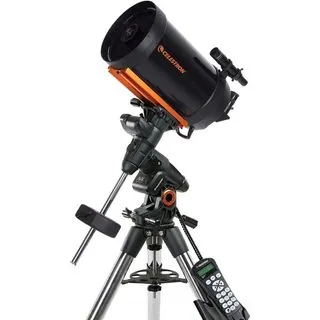 Celestron Advanced VX 8 EdgeHD Schmidt-Cassegrain TelescopeBest for deep spaceCelestron Advanced VX 8 EdgeHD
Celestron Advanced VX 8 EdgeHD Schmidt-Cassegrain TelescopeBest for deep spaceCelestron Advanced VX 8 EdgeHD
Advanced amateur telescope for deep-sky viewing
An excellent choice for experienced amateur astronomers, this amateur telescope is particularly strong for astrophotography thanks to its Edge HD technology. Although somewhat heavy, its robust capacity supports significant equipment loads. Read more below.
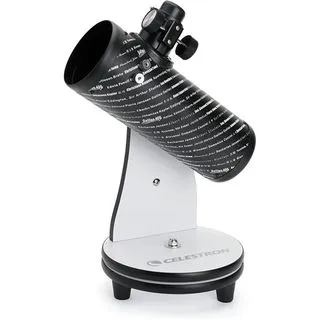 Celestron Classic Firstscope 76mm Tabletop TelescopeBest for kidsCelestron FirstScope 76 Tabletop telescope
Celestron Classic Firstscope 76mm Tabletop TelescopeBest for kidsCelestron FirstScope 76 Tabletop telescope
Ideal amateur telescope for young stargazers
This tabletop amateur telescope provides a fantastic entry point for both young and novice amateur astronomers. It’s easy to assemble and pack away, making it a convenient, albeit less powerful, option. Read more below.
Best Amateur Telescopes for 2025: Detailed Recommendations
Our confidence in recommending the best amateur telescopes comes from thorough testing and direct experience. Space.com’s expert reviewers dedicate significant time to using and evaluating each product, ensuring our recommendations are informed and reliable. We assess everything from observational performance to ease of setup and claimed features.
Best for Beginners
Image 1 of 7
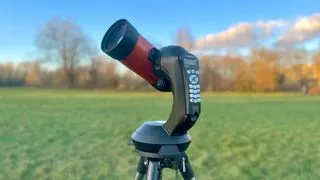 Amateur astronomer setting up a Celestron Nexstar 4SE telescope in a field
Amateur astronomer setting up a Celestron Nexstar 4SE telescope in a field
Our comprehensive review of the Nexstar 4SE highlighted its swift and simple setup, making it an ideal amateur telescope for beginners seeking a high-quality Go-To model. (Image credit: Jonathan Lansley-Gordon)
 Side view of a Celestron Nexstar 4SE amateur telescope in a field
Side view of a Celestron Nexstar 4SE amateur telescope in a field
The GoTo functionality of the Celestron NexStar 4SE amateur telescope allows easy location and tracking of celestial objects. (Image credit: Jonathan Lansley-Gordon)
 Close-up of the hand controller for the Celestron NexStar 4SE amateur telescope
Close-up of the hand controller for the Celestron NexStar 4SE amateur telescope
This amateur telescope model is compact enough to comfortably fit on a tabletop. (Image credit: Jonathan Lansley-Gordon)
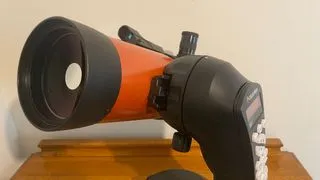 Detailed view of the fork arm mount on a Celestron NexStar 4SE amateur telescope
Detailed view of the fork arm mount on a Celestron NexStar 4SE amateur telescope
The NexStar 4SE features a 4-inch (102mm) aperture, characteristic of many suitable amateur telescopes, and a 1325mm focal length. (Image credit: Jonathan Lansley-Gordon)
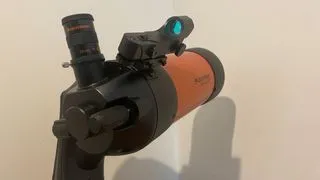 Close-up of the finderscope on the Celestron NexStar 4SE amateur telescope
Close-up of the finderscope on the Celestron NexStar 4SE amateur telescope
The 4SE amateur telescope incorporates a built-in star diagonal controlled by a flip mirror. (Image credit: Jonathan Lansley-Gordon)
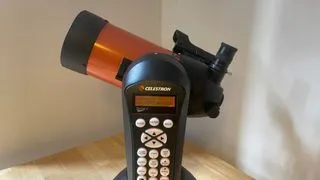 Side profile of the Celestron NexStar 4SE amateur telescope on a wooden table
Side profile of the Celestron NexStar 4SE amateur telescope on a wooden table
Celestron’s distinctive orange tube design is visually striking, making this amateur telescope easily recognizable. (Image credit: Jonathan Lansley-Gordon)
 Amateur astronomer operating a Celestron NexStar 4SE telescope in a backyard
Amateur astronomer operating a Celestron NexStar 4SE telescope in a backyard
Setting up the Celestron 4SE is straightforward for an amateur telescope, though its transportability could be improved. (Image credit: Jonathan Lansley-Gordon)
Celestron NexStar 4SE
Best for finding planets: This amateur telescope model simplifies locating celestial objects using Celestron’s SkyAlign technology.
Our expert review:
Specifications
Optical design: Maksutov-Cassegrain
Mount type: Computerized Alt-Azimuth
Aperture: 4-inches / 102mm
Focal length: 1325mm
Highest useful magnification: 241x
Lowest useful magnification: 15x
Supplied eyepieces: 25mm
Weight: 23 lbs (10.44kg) fully assembled
Reasons to buy
+Uncomplicated, quick setup
+Auto finds night sky objects
+High quality, sturdy build
+No collimation required
Reasons to avoid
-Narrow field of view
-Not very portable
-Limited accessories supplied
Buy it if
✅ It’s your first telescope: This amateur telescope is designed for ease of use and setup, making it perfect for beginner astronomers.
✅ You want GoTo technology: You can easily find and track specific celestial objects with little or no prior knowledge, a great benefit for amateur telescopes.
Don’t buy it if:
❌ You want to travel with it: This amateur telescope is less portable due to its tripod design.
The bottom line:
🔎 Celestron NexStar 4SE: An excellent choice among amateur telescopes if you prioritize effortless viewing of planets and bright objects. ★★★★
The Celestron NexStar 4SE stands out as a fantastic amateur telescope choice, especially for beginners, thanks to its fully computerized mount. The integrated SkyAlign technology simplifies the process of finding celestial targets; it uses the current date, time, and location to automatically locate objects in the night sky at the push of a button, providing an easy introduction to stargazing for newcomers. This feature is particularly helpful for those starting with amateur telescopes who may not yet be familiar with navigation techniques.
This amateur telescope boasts a 4-inch (102mm) aperture and a 1,325mm focal length, providing sharp views of planets and other bright celestial bodies. However, this configuration results in a narrow 1.2-degree field of view, which might make it challenging to frame larger deep-sky objects. While it comes with a 25mm Plossl eyepiece, investing in a 32mm eyepiece and a Barlow lens is recommended to maximize its 241x highest useful magnification potential.
The NexStar 4SE is built with a sturdy design, reflected in its weight of 23 lbs (10.4 kg). This makes it one of the heavier amateur telescopes on this list and less portable as its tripod doesn’t fully collapse. Another consideration is its power consumption; the mount quickly depletes the 8x AA batteries required, suggesting an external power source is more practical for regular use. Consequently, this amateur telescope is perhaps best suited for backyard observation rather than travel.
Swipe to scroll horizontally
Celestron NexStar 4SE
| Attributes | Notes |
|—|—|
| Design | Solid and sturdy build, signature orange colors. |
| Performance | Great for observing the moon and planets. |
| Functionality | Alignment correction can be tricky. |
Best Budget Telescope
Image 1 of 7
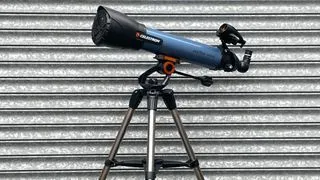 Celestron Inspire 100AZ amateur telescope against a corrugated iron background
Celestron Inspire 100AZ amateur telescope against a corrugated iron background
The Celestron Inspire 100AZ comes with a useful set of accessories, though after our testing, upgrading the eyepieces is recommended for this amateur telescope. (Image credit: Jamie Carter)
 Close-up of the focusing knob on the Celestron Inspire 100AZ amateur telescope tube
Close-up of the focusing knob on the Celestron Inspire 100AZ amateur telescope tube
Setting up and using this amateur telescope is simple, even for those new to astronomy. (Image credit: Jamie Carter)
A small red flashlight fits into the tripod, illuminating the accessory tray – a thoughtful feature for an amateur telescope. (Image credit: Jamie Carter)
 The finderscope attachment on the Celestron Inspire 100AZ amateur telescope
The finderscope attachment on the Celestron Inspire 100AZ amateur telescope
A StarPointer Pro finderscope, featuring a bullseye reticle, is positioned near the eyepiece on this amateur telescope. (Image credit: Jamie Carter)
 The eyepiece and dust cap for the Celestron Inspire 100AZ amateur telescope
The eyepiece and dust cap for the Celestron Inspire 100AZ amateur telescope
The lens cap on this amateur telescope includes elastic cords for securing a smartphone on one side, with an eyepiece on the other. (Image credit: Jamie Carter)
 Demonstration of the smartphone holder on the Celestron Inspire 100AZ amateur telescope
Demonstration of the smartphone holder on the Celestron Inspire 100AZ amateur telescope
A smartphone is attached using elastic cords while an eyepiece is on the other side – a unique feature for capturing images with this amateur telescope. (Image credit: Jamie Carter)
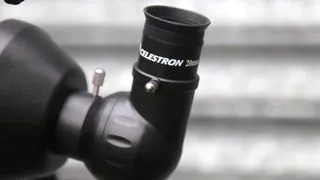 Side view of the star diagonal on the Celestron Inspire 100AZ amateur telescope
Side view of the star diagonal on the Celestron Inspire 100AZ amateur telescope
The Celestron Inspire 100AZ amateur telescope includes 20mm and 10mm Kellner eyepieces. (Image credit: Jamie Carter)
Celestron Inspire 100AZ Refractor
Best budget amateur telescope for budding skywatchers who want to get up and running quickly.
Our expert review:
Specifications
Optical design: Refractor
Mount type: Alt-azimuth
Aperture: 3.94-inches / 100mm
Focal length: 660mm
Highest useful magnification: 241x
Lowest useful magnification: 15x
Supplied eyepieces: 10mm, 25mm
Weight: 20 lbs (9.07kg)
Reasons to buy
+Sharp views of planets and the moon
+Handy smartphone adaptor
+Built-in red light
+Lightweight frame
Reasons to avoid
-Bearings lack precision
-Some chromatic aberration
-No solar observing possible
Buy it if
✅ You’re a beginner: We found it easy to set up and take down, perfect for those new to using amateur telescopes.
✅ You want to take astro shots on your smartphone: The lens cap ingeniously converts into a smartphone holder, enabling you to capture images of the night sky with this amateur telescope.
Don’t buy it if:
❌ You aren’t confident locating objects yourself: This amateur telescope lacks GoTo technology, requiring you to manually locate celestial objects (perhaps with a stargazing app’s aid).
❌ You want detailed views of deep sky objects: While offering great views of planets and the moon, this amateur telescope may provide less impressive views of more distant objects.
The bottom line
🔎 Celestron Inspire 100AZ: Targeted at beginners and upgraders, this 4-inch refractor performs optimally for lunar and planetary views. Its converting lens cap/smartphone holder is a neat feature for amateur astrophotography. ★★★★
The Celestron Inspire 100AZ is an excellent entry point into the world of amateur telescopes. Its user-friendly design and robust build make it straightforward to operate, even for complete novices, while its relatively low price point positions it as an affordable alternative within this guide. This refractor amateur telescope, with a 4-inch/100mm aperture and a focal length of 660mm, is well-suited for observing planets, the moon, and some brighter deep-sky objects from home. It sits on a simple altazimuth mount, controlled with a panhandle, allowing easy up-and-down and side-to-side movement.
The 100mm aperture effectively gathers light, enabling clear observations of fainter objects like nebulae and galaxies. Its focal length provides good magnification for detailed views of closer bodies such as planets. During our review, we did observe some chromatic aberration (purple fringing) and slight blurring at the field edges, which is somewhat common in budget refractor amateur telescopes. Upgrading the eyepieces can significantly enhance the optical performance. The false color issue is generally minor and shouldn’t deter most amateur astronomers unless color accuracy is a primary concern.
This amateur telescope package includes several accessories: two eyepieces (20mm and 10mm), a red LED flashlight to preserve night vision, an accessory tray, and a StarPointer Pro finderscope. A standout feature is the lens cap that cleverly functions as a smartphone adapter, facilitating basic astrophotography.
Swipe to scroll horizontally
Celestron Inspire 100AZ
| Attributes | Notes |
|—|—|
| Design | Fairly lightweight. |
| Performance | Excels with lunar views. |
| Functionality | Easy to set up and take down. |
Best Value for Enthusiasts
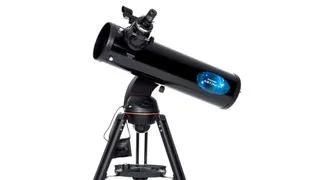 The Celestron Astro Fi 130 amateur telescope on a white background
The Celestron Astro Fi 130 amateur telescope on a white background
The wide field of view offered by the Celestron Astro Fi 130 amateur telescope minimizes the need for frequent repositioning when viewing large galaxies. (Image credit: B&H Photo)
Celestron Astro Fi 130
Best value amateur telescope for enthusiasts: A well-equipped guide to the night sky, offering advanced technology at an accessible price.
Our expert review:
Specifications
Optical design: Newtonian Reflector
Mount type: Computerized altitude-azimuth single fork
Aperture: 5.19-inches / 130mm
Focal length: 650mm
Highest useful magnification: 307x
Lowest useful magnification: 19x
Supplied eyepieces: 25mm and 10mm
Weight: 18 lbs (8.6kg)
Reasons to buy
+Suitable for low budgets
+Great entry-level telescope
+Vixen dovetail for mount changes
+Portable
+Computer recommends targets
+Finds targets at touch of button
Reasons to avoid
-Eyepieces limit observations
-Focuser of low quality
-Battery drains quickly
-Useless without app
Buy it if
✅ You want a beginner-friendly, grab & go, easy-to-use telescope: We found this to be a great entry-level amateur telescope that can locate targets effortlessly and is excellent for portable observations.
Don’t buy it if:
❌ You want a ‘traditional’ telescope: This amateur telescope relies heavily on its app for functionality, making it unsuitable if you prefer a telescope without significant technological integration.
The bottom line
🔎 Celestron Astro Fi 130: A capable amateur telescope offered at an exceptional price point. It includes everything needed for beginners to start, though upgrading some components is advisable. Be mindful of battery drain in cold conditions. ★★★½
Celestron’s Astro Fi 130 is a highly capable amateur telescope that offers excellent value for money. This well-built instrument features a Newtonian reflector tube mounted on a sturdy aluminum tripod, complete with 10mm and 25mm Kellner eyepieces providing 65x and 26x magnification, respectively, and a red dot finder. For serious amateur astronomers looking to maximize performance, upgrading to mid-range Plossl eyepieces is strongly recommended. During our review, we noted that the batteries tend to drain quickly in cold weather, so investing in 12V rechargeable batteries might be a wise decision for this amateur telescope.
This telescope is an excellent choice for beginners, providing all the necessary tools to embark on their stargazing journey. Its SkyAlign technology removes the need for prior knowledge of the night sky to get set up, and the Celestron SkyPortal app allows easy control via smartphone or tablet. The app can even suggest celestial objects to view and automatically guide the computerized mount to them.
The optics of the Astro Fi 130 deliver good views of the moon, with sufficient magnification to reveal craters and rilles. Venus and Mars are easily discernible, and we were even able to catch a glimpse of the Andromeda Galaxy. This versatility makes it a compelling option among amateur telescopes.
Swipe to scroll horizontally
Celestron Astro Fi 130
| Attributes | Notes |
|—|—|
| Design | Very sturdy build with well constructed tube and tripod. |
| Performance | Makes use of SkyAlign technology for easy alignment. |
| Functionality | Great for lunar and planetary observing, but some views are fuzzy. |
Best Premium
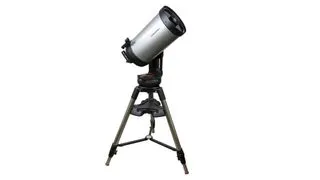 The Celestron NexStar Evolution 9.25 amateur telescope on a tripod on a white background
The Celestron NexStar Evolution 9.25 amateur telescope on a tripod on a white background
Automatically track celestial objects as they traverse the sky with this high-quality Catadioptric amateur telescope. (Image credit: B&H Photo)
Celestron NexStar Evolution 9.25
Best GoTo amateur telescope for seeing the universe in high definition, balanced against a premium price point.
Our expert review:
Specifications
Optical design: Schmidt-Cassegrain
Mount type: Computerized alt-azimuth fork arm
Aperture: 9.25-inches / 235mm
Focal length: 2350mm
Highest useful magnification: 555x
Lowest useful magnification: 34x
Supplied eyepieces: 13mm, 40mm
Weight: 62.60 lbs (28.39kg)
Reasons to buy
+Crisp views with no defects
+Easy to set up
+High-quality design
Reasons to avoid
-Isn’t very portable — best for backyard star gazing
-Expensive
Buy it if
✅ You want to view a wide range of subjects: This amateur telescope boasts a large aperture, enabling clear and detailed views of various celestial objects, including planets, deep-sky objects, and nebulae.
✅ You’re an experienced skywatcher: While easy to set up for beginners, this amateur telescope is optimally suited for more advanced, passionate amateur astronomers seeking comprehensive views of the universe.
Don’t buy it if:
❌ You want something portable: Portability is not a strong suit of the Evolution 9.25, making this amateur telescope best suited for fixed-location backyard stargazing.
The bottom line
🔎 Celestron NexStar Evolution 9.25: A superb amateur telescope ideally suited for experienced skywatchers, with a price tag reflecting its premium features. Although not easily transportable, it stands out as one of the best GoTo amateur telescopes available. ★★★★½
The Celestron NexStar Evolution 9.25 is an exceptional GoTo amateur telescope, providing breathtaking views of the night sky. Its Schmidt-Cassegrain optical tube features a substantial 235mm aperture supported by a sturdy single-fork arm mount, ensuring stability and precision crucial for amateur astronomers. The motorized mount is powered by a rechargeable lithium-ion battery offering an impressive 10 hours of continuous observation.
This amateur telescope includes a good array of accessories: a red dot finderscope, star diagonal, accessory tray, international AC adapter, hand control, and two eyepieces (13mm and 40mm). Unlike some simpler models, the NexStar Evolution 9.25 is a prime choice for more experienced amateur astronomers seeking a high-performance instrument. While a significant investment, its impressive design and quality features justify the cost for dedicated enthusiasts.
Astrophotographers will also appreciate this amateur telescope and its motorized mount’s ability to track celestial objects smoothly. Control is easily managed through the free Celestron SkyPortal app, eliminating the need for a separate controller and freeing up hands during imaging sessions. Despite its impressive capabilities, this amateur telescope is heavy, limiting its portability. It’s best suited for stationary use in a backyard observatory setup, where its robust construction and excellent features truly shine.
Swipe to scroll horizontally
Celestron NexStar Evolution 9.25
| Attributes | Notes |
|—|—|
| Design | A bit bulky and tricky to transport. |
| Performance | Crisp views with no defects. |
| Functionality | Motorized mount a good choice for astrophotography. |
Best for Astrophotography
Image 1 of 5
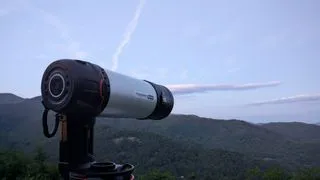 Celestron Origin Intelligent Home Observatory amateur telescope in a field
Celestron Origin Intelligent Home Observatory amateur telescope in a field
The Celestron Origin bears resemblance to a classic Celestron optical tube but notably lacks an eyepiece, functioning differently from traditional amateur telescopes. (Image credit: Future/Brett Tingley)
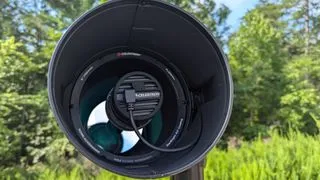 Celestron Origin Intelligent Home Observatory amateur telescope in a field with trees
Celestron Origin Intelligent Home Observatory amateur telescope in a field with trees
The integrated camera in the Celestron Origin smart telescope enables the capture of beautiful night sky images, a key feature for astrophotography enthusiasts. (Image credit: Future/Brett Tingley)
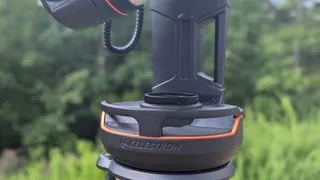 Handles on the mount of the Celestron Origin Intelligent Home Observatory amateur telescope
Handles on the mount of the Celestron Origin Intelligent Home Observatory amateur telescope
Multiple handles on the Origin’s mount facilitate easier carrying of this amateur telescope setup. (Image credit: Future/Brett Tingley)
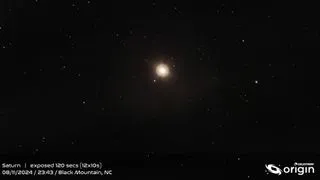 Saturn viewed through the Celestron Origin Intelligent Home Observatory smart telescope
Saturn viewed through the Celestron Origin Intelligent Home Observatory smart telescope
During testing, we were able to view Saturn using the Celestron Origin, though focusing on planets proved challenging with this specific amateur telescope. (Image credit: Future/Brett Tingley)
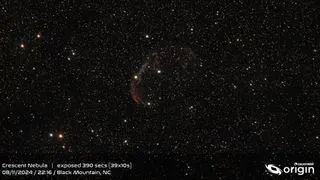 Sharp astrophotography image of the Crescent Nebula taken with the Celestron Origin amateur telescope
Sharp astrophotography image of the Crescent Nebula taken with the Celestron Origin amateur telescope
An example of a sharp astrophotography shot of the Crescent Nebula (NGC 6888) taken without a filter using the Celestron Origin smart telescope. (Image credit: Future/Brett Tingley)
Celestron Origin Intelligent Home Observatory
Best for astrophotography: This smart amateur telescope captures clear deep-sky photos in mere seconds.
Our expert review:
Specifications
Optical design: Rowe-Ackermann Schmidt Astrograph (RASA)
Mount type: Motorized Alt-azimuth
Aperture: 6-inches / 152mm
Focal length: 335mm
Highest useful magnification: N/A
Lowest useful magnification: N/A
Supplied eyepieces: N/A
Weight: 41.6 lbs (18.6 kg)
Reasons to buy
+Crystal clear deep sky photos in seconds
+Quick set up
+Easy-to-use, helpful app
+Stacks and processes images automatically
Reasons to avoid
-Not ideal for all celestial objects
-Quite large and heavy
Buy it if
✅ You want an automated telescope: Focusing, tracking, finding targets, and stacking processed images are all automatic with this smart amateur telescope.
✅ You want to take deep sky images: The Origin excels at this, producing results in minutes with minimal prior knowledge required.
Don’t buy it if:
❌ You want a traditional telescope: This model operates without an eyepiece, providing views only on a mobile device, unlike conventional amateur telescopes.
❌ You’re on a budget: With a price point around $4,000, this is a premium option not typically categorized with standard amateur telescopes.
The bottom line
🔎 Celestron Origin Intelligent Home Observatory: This smart amateur telescope automates nearly every aspect of stargazing and astrophotography, producing stunning deep-sky images rapidly, though its camera resolution is moderate and the price is high. ★★★★½
The Celestron Origin Intelligent Home Observatory represents a departure from typical amateur telescopes, functioning as a smart telescope without a traditional eyepiece, utilizing a built-in camera for viewing and imaging via a mobile device. This innovative approach yields beautiful, clear images of deep-sky objects and distant galaxies in moments, even under light-polluted skies. In our testing, selecting an object in the app resulted in the telescope quickly capturing crystal clear, low-noise images of nebulae. The ‘snapshot’ mode, allowing manual setting adjustments, was also appreciated. However, imaging planets proved less successful, suggesting this amateur telescope might be more specialized for deep-sky targets.
This amateur telescope is user-friendly for beginners due to its quick and easy setup. Its ability to handle focusing, tracking, and target acquisition automatically means you can start exploring the sky with no prior astronomy experience. The accompanying Origin app is intuitive, featuring a ‘Planetarium View’ that mirrors the night sky and allows users to slew the telescope to selected objects from a vast database.
Visually, the Celestron Origin resembles a standard telescope tube but lacks the eyepiece. Its significant weight makes it less suitable for portability compared to other amateur telescopes. The price point, close to $4,000, places it in a higher category than most amateur telescopes, but for those with the budget and a focus on automated deep-sky astrophotography, it is highly recommended.
Swipe to scroll horizontally
Celestron Origin Intellligent Home Observatory
| Attributes | Notes |
|—|—|
| Design | Bulky, but full of useful features on the mount. |
| Performance | Beautiful, clear photos of deep sky objects. |
| Functionality | Motorized mount, but not a traditional telescope with an eyepiece. |
Best Motorized Telescope
Image 1 of 7
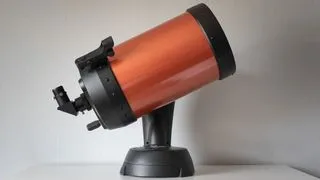 Celestron NexStar 8SE amateur telescope review photo
Celestron NexStar 8SE amateur telescope review photo
The uncluttered sides of the Celestron NexStar 8SE amateur telescope make it easy to handle without damaging components. (Image credit: Jason Parnell-Brookes)
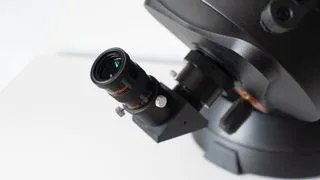 Celestron NexStar 8SE amateur telescope with included 25mm eyepiece
Celestron NexStar 8SE amateur telescope with included 25mm eyepiece
The NexStar 8SE amateur telescope comes with a 25mm eyepiece; a 10mm eyepiece is recommended for closer views. (Image credit: Jason Parnell-Brookes)
 Celestron NexStar 8SE amateur telescope finderscope review photo
Celestron NexStar 8SE amateur telescope finderscope review photo
Despite its basic appearance, the included finderscope on the NexStar 8SE amateur telescope is surprisingly effective. (Image credit: Jason Parnell-Brookes)
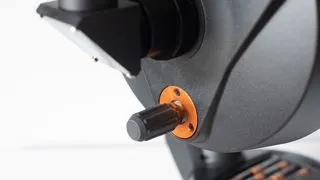 Close-up of the focus knob on the Celestron NexStar 8SE amateur telescope
Close-up of the focus knob on the Celestron NexStar 8SE amateur telescope
The large focus knob on the NexStar 8SE amateur telescope is easily located and operable even in darkness or with gloves. (Image credit: Jason Parnell-Brookes)
 Celestron NexStar 8SE amateur telescope with 203.2mm aperture lens
Celestron NexStar 8SE amateur telescope with 203.2mm aperture lens
The 203.2mm aperture lens of the NexStar 8SE amateur telescope allows for breathtaking detail and vividness in deep-sky objects. (Image credit: Jason Parnell-Brookes)
 Controls on the Celestron NexStar 8SE amateur telescope hand controller
Controls on the Celestron NexStar 8SE amateur telescope hand controller
The controls on the NexStar 8SE amateur telescope are user-friendly, even for beginners. (Image credit: Jason Parnell-Brookes)
 Celestron NexStar 8SE amateur telescope with hand controller
Celestron NexStar 8SE amateur telescope with hand controller
The Celestron NexStar 8SE amateur telescope is controlled via an integrated hand controller, not an app. (Image credit: Jason Parnell-Brookes)
Celestron NexStar 8SE
Best motorized amateur telescope: Ideal for astrophotography and deep-space observation, offering excellent image clarity and detail.
Our expert review:
Specifications
Optical design: Schmidt-Cassegrain
Mount type: Computerized alt-azimuth fork arm
Aperture: 8-inches / 203mm
Focal length: 2032mm
Highest useful magnification: 480x
Lowest useful magnification: 29x
Supplied eyepieces: 25mm
Weight: 32 lbs (14.48kg)
Reasons to buy
+Incredibly bright views
+Sharpness across the entire field of view
+Pricey, but good value for money
Reasons to avoid
-Will price some beginners out
-Slewing using the remote is a little laggy, but not much
Buy it if
✅ You’re looking for a long-term telescope: This amateur telescope, though pricey, is a durable investment known for lasting decades, living up to its reputation as ‘The World’s Most Beloved Telescope’.
✅ You want to use it for astrophotography: Thanks to smooth and accurate tracking, this amateur telescope is a great tool for capturing stunning astro images of deep-sky objects.
Don’t buy it if:
❌ You’re on a budget: While offering great value for its performance, this amateur telescope is significantly expensive. Beginners or those with limited budgets might find more affordable, suitable alternatives.
The bottom line
🔎 Celestron NexStar 8SE: An outstanding amateur telescope with superb optics suitable for astronomers of all levels. It excels in astrophotography and provides beautifully bright, detailed views. Its primary drawback is the cost, which may be prohibitive for some beginners. ★★★★½
The Celestron NexStar 8SE stands out as one of the most versatile amateur telescopes we’ve evaluated, providing ample room for growth and learning. It’s accessible to beginners with no prior knowledge of the night sky, yet its remarkable optics satisfy intermediate to advanced amateur astronomers. While the price is a factor, its performance justifies the investment for serious enthusiasts.
The Celestron SkyAlign app simplifies the alignment process using three bright stars, after which the operation is automated. Users simply select a celestial object from categories like ‘solar system,’ ‘stars,’ or ‘deep sky’ using the handheld remote, and the motorized mount slews the amateur telescope to the target. A ‘sky tour’ option even suggests objects of interest based on location.
With an 8-inch aperture and Schmidt-Cassegrain optical design, this amateur telescope captures substantial light, delivering bright, clear views of objects within our solar system and beyond. The catadioptric design keeps the distinctive orange tube relatively short, contributing to portability for seeking darker skies. In our review, the smoothness and accuracy of the motorized fork arm were particularly impressive, making this amateur telescope a strong contender for long-exposure astrophotography. Note that it requires 8x AA batteries, so rechargeable batteries are recommended for this power-hungry instrument. The long-term usability and capabilities of the Celestron NexStar 8SE make it a solid investment for amateur astronomers.
Swipe to scroll horizontally
Celestron NexStar 8SE
| Attributes | Notes |
|—|—|
| Design | Can be transported as a fully-assembled setup. |
| Performance | Outstanding optics, slightly tricky to align if you’re not used to it. |
| Functionality | Easy to assemble and disassemble. |
Best for Portability
Image 1 of 7
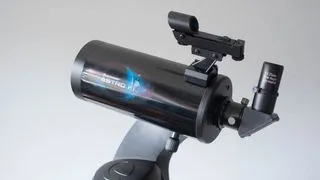 Celestron Astro Fi 102 amateur telescope front view
Celestron Astro Fi 102 amateur telescope front view
While perhaps not the most aesthetically pleasing, and possibly appearing somewhat “toyish,” the Celestron Astro Fi 102 amateur telescope offers good optical quality for its class. (Image credit: Jason Parnell-Brookes)
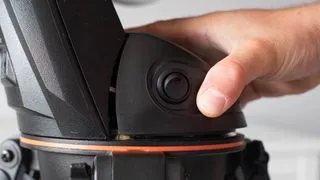 Side view of the Celestron Astro Fi 102 amateur telescope emphasizing portability
Side view of the Celestron Astro Fi 102 amateur telescope emphasizing portability
Despite its excellent portability, we found the finish of this amateur telescope lacks a premium feel. (Image credit: Jason Parnell-Brookes)
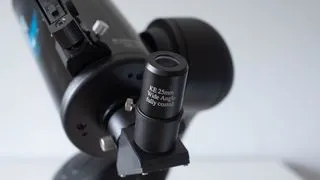 Eyepieces included with the Celestron Astro Fi 102 amateur telescope
Eyepieces included with the Celestron Astro Fi 102 amateur telescope
The amateur telescope package includes 25mm and 10mm eyepieces, providing 53x and 132.5x magnification respectively. (Image credit: Jason Parnell-Brookes)
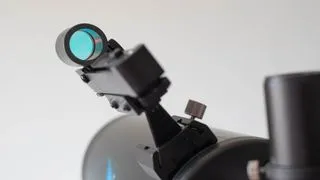 Attaching the finderscope to the Celestron Astro Fi 102 amateur telescope tube
Attaching the finderscope to the Celestron Astro Fi 102 amateur telescope tube
The finderscope attaches easily to the tube of this amateur telescope. (Image credit: Jason Parnell-Brookes)
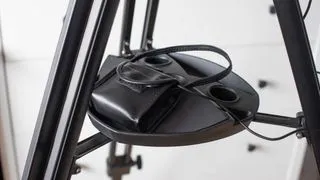 Accessory tray for the Celestron Astro Fi 102 amateur telescope
Accessory tray for the Celestron Astro Fi 102 amateur telescope
The accessory tray is useful for keeping gear organized and accessible in the dark, a convenient feature for any amateur telescope user. (Image credit: Jason Parnell-Brookes)
 Battery pack for the Celestron Astro Fi 102 amateur telescope
Battery pack for the Celestron Astro Fi 102 amateur telescope
This amateur telescope’s battery pack requires 8 AA batteries; a more robust cable connection would be an improvement. (Image credit: Jason Parnell-Brookes)
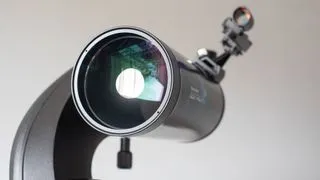 Optical tube assembly dimensions of the Celestron Astro Fi 102 amateur telescope
Optical tube assembly dimensions of the Celestron Astro Fi 102 amateur telescope
The optical tube assembly of this amateur telescope measures 38.1cm in length and 11.7cm in diameter. (Image credit: Jason Parnell-Brookes)
Celestron Astro Fi 102
Best lightweight and portable Go-To mount amateur telescope for beginner skywatchers.
Our expert review:
Specifications
Optical design: Maksutov-Cassegrain
Mount type: Computerized Alt-Azimuth Single Fork Arm
Aperture: 4.0-inches / 102mm
Focal length: 1325mm
Highest useful magnification: Up to 100x with digital zoom
Lowest useful magnification: 15x
Supplied eyepieces: 25mm and 10mm
Weight: 6 lbs (2.7kg)
Reasons to buy
+Very portable thanks to its lightweight design
+Reasonably and fairly priced
+No prior experience needed
Reasons to avoid
-Optics could be better
-Tripod isn’t the best quality
-Doesn’t feel like a premium product to the touch
Buy it if
✅ You’ll be traveling with it: This amateur telescope is our top pick for portability, making it ideal for taking on camping trips or to darker observing sites.
✅ You’re a beginner: If your goal is primarily to view the moon and planets, this amateur telescope is an excellent choice.
Don’t buy it if:
❌ You want good quality parts: This amateur telescope reflects its price point; it’s sufficient for basic astronomy, but the tripod is flimsy, optics could be improved, and it lacks a premium feel.
The bottom line
🔎 Celestron Astro Fi 102: Best suited for observing the moon and planets, this amateur telescope is great for beginners and those without prior experience. Initial setup can be tricky, and it’s not the highest quality scope, but it’s functional. ★★★½
The Celestron Astro Fi 102 offers several advantages for newcomers to amateur astronomy. It’s relatively easy to set up, features a motorized mount for automatic target acquisition, and is affordably priced for a Maksutov-Cassegrain scope. It also includes various convenient features and accessories to help beginners get started with their first amateur telescope.
One of the standout features noted in our review was the portability of this amateur telescope. Its compact body and low weight (only 6 lbs / 2.7kg) make it extremely easy to transport for field observations. However, it’s important to note that it may not be as durable as more expensive models and could be vulnerable to moisture. A sturdier tripod would also enhance stability.
This amateur telescope comes with integrated WiFi, allowing pairing with a smartphone via the Celestron SkyPortal app. The app contains a vast database of celestial objects, simplifying navigation for beginners who can select targets for the telescope to automatically slew to. For its price, the Celestron Astro Fi 102 provides good views of the moon’s craters and closer planets like Mars, Saturn, and Jupiter. Under good conditions, you might even catch glimpses of Uranus or Neptune. Some sharpness drop-off towards the edges is present, which is typical for amateur telescopes in this price range. While the plastic casing is acceptable, its lack of robust sealing means it’s not as resilient to impacts or rain as some hardier models.
Swipe to scroll horizontally
Celestron Astro Fi 102
| Attributes | Notes |
|—|—|
| Design | Highly transportable, but tripod needs weighing down. |
| Performance | Initial setup can be tricky, but after that it’s a breeze. |
| Functionality | Large database of celestial objects on SkyPortal. |
Best for Accessories
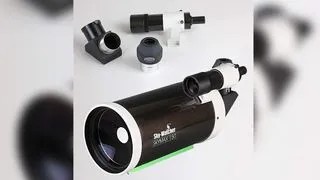 Sky-Watcher Skymax 150 PRO amateur telescope and accessories laid out
Sky-Watcher Skymax 150 PRO amateur telescope and accessories laid out
This amateur telescope is a versatile tool for astrophotography, capable of capturing various subjects from planets to deep-sky objects. (Image credit: Amazon)
Sky-Watcher Skymax 150 PRO
Best amateur telescope for accessories: The Skymax 150 PRO is highly adaptable, accommodating CCD or DSLR cameras, filter wheels, and other add-ons.
Our expert review:
Specifications
Optical design: Maksutov-Cassegrain
Mount type: Equatorial (EQ-5 Pro)
Aperture: 5.90-inches / 150mm
Focal length: 1800mm
Highest useful magnification: 450x
Lowest useful magnification: 36x
Supplied eyepieces: 28 mm
Weight: 13.23 lbs (6kg)
Reasons to buy
+High-quality, lightweight build
+Excellent optics
+Great for a wide selection of astrophotography
Reasons to avoid
-Not all models come with a tripod
-Comes with only one eyepiece
Buy it if
✅ You want to travel with it: Much amateur astrophotography involves traveling to dark sky sites, and this amateur telescope is light enough for such trips.
✅ Your primary focus is astrophotography: We recommend this amateur telescope as one of the best thanks to its superb optics tailored for imaging.
Don’t buy it if:
❌ You’re looking for something super sophisticated: For those seeking high-end, automated smart telescopes and have the budget for them, a smart telescope might be a better fit than this type of amateur telescope.
The bottom line
🔎 Sky-Watcher Skymax 150 PRO: This amateur telescope is perfect for astrophotographers who need portability and excellent optics. It accommodates many accessories but note that some packages may not include a tripod. ★★★★
The Sky-Watcher Skymax 150 is an excellent amateur telescope choice, particularly for astrophotographers, due to its high-quality equatorial mount suitable for both short and long exposures. Weighing just 13.23 lbs (6kg), this amateur telescope is easy to transport to different locations for optimal dark-sky conditions. It pairs well with various equatorial mounts and readily accepts additional accessories like CCD or DSLR cameras, filter wheels, and more, featuring a Vixen-style dovetail plate for easy attachment.
This well-built Maksutov-Cassegrain amateur telescope includes a 28mm focal length eyepiece, providing 64x magnification for detailed views of celestial objects. The optics of the Skymax 150 are impressive, offering crisp, distortion-free images, making it a versatile instrument for capturing images of planets, distant galaxies, and nebulae. Its user-friendly nature and ease of accessorizing make it a great fit for amateur astronomers and astrophotographers at various skill levels. Compared to other instruments on this list, the Skymax 150 offers very good value.
The focuser operation is remarkably smooth, and the telescope maintains fine focus well, which is crucial for extended astrophotography sessions. This quality contributes significantly to its appeal as an amateur telescope for serious imaging.
Swipe to scroll horizontally
Sky-Watcher Skymax 150 PRO
| Attributes | Notes |
|—|—|
| Design | High quality build, excellent optics. |
| Performance | Outstanding optics, with no sign of distortion. |
| Functionality | Great for a wide selection of astrophotography. |
Best Smart Telescope
Image 1 of 3
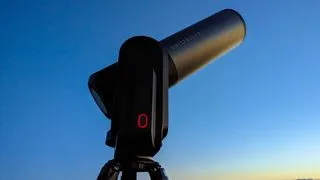 Unistellar eQuinox 2 smart amateur telescope in use against the night sky
Unistellar eQuinox 2 smart amateur telescope in use against the night sky
The Unistellar eQuinox 2 can smoothly and silently slew to night sky objects and image them within minutes, offering a modern take on amateur telescopes. (Image credit: Jason Parnell-Brookes)
 Unistellar eQuinox 2 smart amateur telescope against a starry sky
Unistellar eQuinox 2 smart amateur telescope against a starry sky
This smart amateur telescope features only a single power button on the fork arm, glowing red when active and connected. (Image credit: Jason Parnell-Brookes)
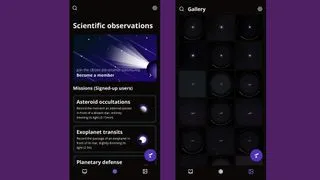 Screenshots of the Unistellar app controlling the eQuinox 2 smart amateur telescope
Screenshots of the Unistellar app controlling the eQuinox 2 smart amateur telescope
All functions of this smart amateur telescope are accessed via its accompanying smartphone app. (Image credit: Jason Parnell-Brookes)
Unistellar eQuinox 2 telescope
Best smart amateur telescope: This intelligent telescope offers simplified astronomy powered by a clever smartphone app.
Our expert review:
Specifications
Optical design: Newtonian Reflector
Mount type: Motorized GoTo alt-azimuth
Aperture: 4.49-inches / 114mm
Focal length: 450mm
Highest useful magnification: 400x digital
Lowest useful magnification: 50x optical
Supplied eyepieces: N/A
Weight: 19.8 lbs (9kg)
Reasons to buy
+Beautiful, simple layout and design
+Get views of the night sky fast
+App is easy to operate
Reasons to avoid
-Image resolution is average
-Can’t orientate telescope in twilight
-Laggy views when focusing
Buy it if
✅ You live in an urban area: This amateur telescope features a Smart Light Pollution Reduction feature, making it an excellent option if you are not located near a dark sky site.
✅ You want simplicity: This sleek, all-in-one amateur telescope requires no additional accessories and effortlessly guides you to your chosen celestial objects.
Don’t buy it if:
❌ You’re on a budget: As a high-tech instrument, this smart amateur telescope is expensive, likely pricing out most beginners and those with limited budgets.
The bottom line
🔎 Unistellar eQuinox 2: An easy-to-use motorized smart amateur telescope capable of locating night sky objects instantly via an app. It allows exploring the stars rapidly without prior knowledge, although its built-in camera resolution is moderate. ★★★★½
The Unistellar eQuinox 2 integrates advanced smart technology into a streamlined motorized reflector telescope, offering a departure from traditional amateur telescopes. It features only a power button, with all other controls managed through the Unistellar app. Unlike conventional amateur telescopes, it does not include a finderscope, eyepieces, or other accessories, as it is designed for viewing and imaging directly on a mobile device.
The telescope incorporates a 6.2MP image sensor that captures and stacks multiple images, creating the appearance of a long exposure. This process enhances object brightness in real-time on your screen. This approach may not appeal to amateur astronomers who prefer the tactile experience of traditional viewing, but it offers significant advantages in light-polluted urban environments thanks to its Smart Light Pollution Reduction feature. The ability to easily save and share images in real-time is also a plus.
During our review, setting up this amateur telescope was quick and easy using the Autonomous Field Detection feature. Unistellar’s intuitive app allows seamless navigation to different night sky objects, presenting a menu of currently viewable objects and those appearing soon. Users can also search a vast database of stars and celestial objects. It’s important to note that this high-tech amateur telescope comes with a price tag around $2,000. If your budget allows, the Unistellar eQuinox 2 is a compelling option.
Swipe to scroll horizontally
Unistellar eQuinox 2 telescope
| Attributes | Notes |
|—|—|
| Design | Slim, sleek, neat package. |
| Performance | Quick go to location of night sky objects. |
| Functionality | Doesn’t orientate until well after twilight, easy once oriented. |
Best for Deep Space
Image 1 of 4
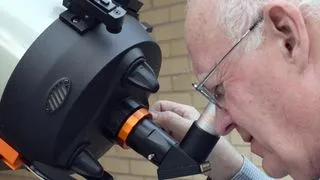 Celestron Advanced VX 8 Edge HD amateur telescope on mount
Celestron Advanced VX 8 Edge HD amateur telescope on mount
The Celestron Advanced VX8 amateur telescope comes packaged with Celestron’s imager-focused Advanced VX mount. (Image credit: Future/Michael Covington)
 Computerized mount of the Celestron Advanced VX8 Edge HD amateur telescope
Computerized mount of the Celestron Advanced VX8 Edge HD amateur telescope
This amateur telescope features a computerized mount that finds celestial objects, controlled via hand box or PC connection. (Image credit: Future/Michael Covington)
 Attaching a camera to the Celestron Advanced VX8 Edge HD amateur telescope
Attaching a camera to the Celestron Advanced VX8 Edge HD amateur telescope
An astrocamera or DSLR (not included) attaches in place of the eyepiece for photography through this amateur telescope. (Image credit: Future/Michael Covington)
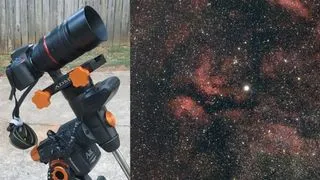 Advanced VX mount with camera and lens for deep-sky imaging with the Celestron Advanced VX8 Edge HD amateur telescope
Advanced VX mount with camera and lens for deep-sky imaging with the Celestron Advanced VX8 Edge HD amateur telescope
The Advanced VX mount (shown with aftermarket saddle) on this amateur telescope can support camera and telephoto lens setups for dramatic deep-sky images. (Image credit: Future/Michael Covington)
Celestron Advanced VX 8 EdgeHD
Best for pinpoint sharpness across the whole field of view, this is an amateur telescope for veteran astronomers.
Our expert review:
Specifications
Optical design: Schmidt-Cassegrain
Mount type: Motorized equatorial
Aperture: 8-inches / 203.2mm
Focal length: 2032mm
Highest useful magnification: 480x
Lowest useful magnification: 29x
Supplied eyepieces: 40mm
Weight: 61 lbs (27.67kg)
Reasons to buy
+EdgeHD has the best optics available in a telescope of this size
+Computerized mount finds and tracks objects reliably
+Dovetail mount system
+Proven design on the market for years, incrementally refined
Reasons to avoid
-Setting up requires some knowledge of the sky
-Only one eyepiece is supplied
-Needs a sturdier mount for serious long-exposure photography
Buy it if
✅ You want to see everything: While some amateur telescopes specialize, this model excels at viewing all types of celestial objects.
✅ You want a seamless experience: We found the motorized mount on this amateur telescope to be very smooth and efficient.
Don’t buy it if:
❌ You’re a beginner: This amateur telescope is intended for experienced users with existing sky and telescope knowledge, making it less suitable for newcomers.
❌ You want something lightweight: At 61 lbs (27.67kg), this amateur telescope is heavier than most others in this guide.
The bottom line
🔎 Celestron Advanced VX 8 EdgeHD: Designed for serious amateur astronomers, this optically superior telescope is excellent for all visual astronomy, featuring a rugged, lightweight computerized mount. It’s the telescope to acquire if you have existing sky knowledge and plan for long-term engagement in astronomy. ★★★★½
Celestron’s EdgeHD technology significantly enhances Schmidt-Cassegrain amateur telescopes, particularly for astrophotography. Standard Schmidt-Cassegrains often suffer from field curvature, causing stars at the image edges to appear blurred due to a mismatch between the curved focal plane and flat camera sensors. EdgeHD technology corrects this, providing a perfectly flat field and enabling astrophotographers using this amateur telescope to capture sharp, detailed images across the entire frame.
During our review of the Celestron Advanced VX 8 EdgeHD, the optics impressed us by eliminating blurred edges and providing pinpoint sharpness across the entire field of view. The optical performance is exceptional, with crisp, clear views free from distortion or false color. This makes it a superior amateur telescope for discerning observers.
This amateur telescope has a weight capacity of up to 30 lbs (13.6kg), ensuring stable support for the tube and accessories. The package includes the standard NexStar+ hand controller, a 40mm eyepiece, and access to Celestron’s SkyPortal app and Starry Night software. A notable bonus for astrophotographers is the inclusion of Celestron’s Advanced VX mount, designed to image across the meridian without requiring a meridian flip. It also features periodic error correction and an auto guider port, essential for serious amateur telescopes used in imaging.
Views of Saturn and Jupiter are dramatic; globular clusters are resolved into individual stars; all Messier Objects are easily visible. With clear, dark skies and a practiced eye, galaxies down to 12th magnitude are observable. This is an amateur telescope that offers capabilities you won’t quickly outgrow.
Swipe to scroll horizontally
Celestron Advanced VX 8 EdgeHD
| Attributes | Notes |
|—|—|
| Design | EdgeHD optical design outperforms standard Schmidt-Cassegrain. |
| Performance | Finds and tracks celestial objects reliably. |
| Functionality | Great views of all types of celestial objects. |
Best for Kids
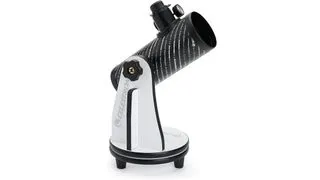 Celestron FirstScope 76 Tabletop amateur telescope on a white background
Celestron FirstScope 76 Tabletop amateur telescope on a white background
The Celestron FirstScope is an affordable tabletop instrument designed to spark interest in sky-watching for children, making it a perfect first amateur telescope. (Image credit: Amazon)
Celestron FirstScope 76 Tabletop telescope
Best tabletop amateur telescope suited for on-the-go young astronomers with small hands.
Our expert review:
Specifications
Optical design: Reflector
Mount type: Dobsonian
Aperture: 2.99-inch / 76mm
Focal length: 11.81-inch / 300mm
Highest useful magnification: 180x
Lowest useful magnification: 11x
Supplied eyepieces: 4mm, 20mm
Weight: 4.5 lbs / 2.04kg
Reasons to buy
+Portable
+Easy to use
+Robust build
+Low investment for casual or young astronomers
+Fast focal ratio for easy observations of wide-angle targets
Reasons to avoid
-Loose focuser
-Some observations lack clarity and detail
-A challenge to collimate
-Finderscope not supplied
Buy it if
✅ You want low investment: For casual viewing, this amateur telescope is a great, affordable option.
✅ You don’t want to spend ages setting it up: It arrives fully assembled and ready for immediate use, simplifying the process for a first amateur telescope.
Don’t buy it if:
❌ You want to find objects easily: It lacks a finderscope, which might frustrate users trying to locate specific celestial objects, a common tool with most amateur telescopes.
❌ You want all the extras: This amateur telescope package doesn’t include a finderscope, requiring a separate purchase or consideration of a different package.
The bottom line
🔎 Celestron FirstScope 76 Tabletop Telescope: If you’re considering an amateur telescope for children interested in the moon and casual stargazing without committing to a more expensive instrument, the FirstScope is an ideal solution. ★★★★
True to its name, the Celestron FirstScope 76 is designed as an excellent initial amateur telescope for kids. Its ease of setup and use is a major plus, arriving fully assembled and ready out of the box – perfect for impatient young astronomers eager to start. In our review, we noted its suitability for smaller hands, with the tube easily maneuvered to point at targets. It includes two basic eyepieces (4mm and 20mm) for decent observations.
This amateur telescope features a 76mm aperture (nearly three inches) and a fast f/3.95 focal ratio, allowing detection of celestial objects and some fainter deep-sky targets. While not providing high-magnification close-ups, it’s sufficient for newcomers. We were impressed by the views of moon craters, considering them a great starting point for young amateur astronomers. The short base necessitates placement on a table for comfortable viewing, which might be a slight limitation for some users. However, for its intended audience and ease of use, it’s a suitable choice.
The Celestron FirstScope 76 is remarkably portable, weighing only 4.5 lbs (2.04kg). Being a tabletop model, it needs a stable surface, making it less ideal for use directly on the ground in the wild. Despite its low price, the amateur telescope is built sturdily with durable, non-glossy plastics, giving it a quality look and feel. The main drawback is the absence of a finderscope, a tool crucial for aligning the telescope and locating objects. Adding an inexpensive red dot finder would significantly enhance the experience for young amateur astronomers.
Swipe to scroll horizontally
Celestron FirstScope 76
| Attributes | Notes |
|—|—|
| Design | Good quality build for the price. |
| Performance | Provides a ‘wow factor’ for young observers. |
| Functionality | Optics struggle to pick out detail. |
Expert Insights on Amateur Telescopes
Choosing the right amateur telescope involves understanding key concepts and how different designs function. Dr Gemma Lavender, a contributing expert and Fellow of the Royal Astronomical Society, provides valuable insights.
Telescope FAQ answered by Dr Gemma Lavender
A contributing expert to Space.com, Live Science, All About Space, and more, Gemma is the author of several books including ‘Quantum Physics in Minutes’. She holds degrees in physical sciences and astrophysics, and a PhD in computational astrophysics. Elected a fellow of the Royal Astronomical Society in 2011, Gemma is also the Communications and Outreach Officer at the European Space Agency.
How do I choose the right amateur telescope for me?
Selecting the perfect amateur telescope can be challenging, especially for beginners wading through technical jargon and numerous options. Modern amateur telescopes generally offer good quality, reducing the risk of acquiring a poor instrument. However, identifying the best fit is still important. The most critical factor is optical quality. You’ll also need to consider the necessary aperture, whether portability is essential, and your specific observational goals (e.g., planets, deep-sky objects).
For beginners, dedicated beginner amateur telescopes are an excellent starting point. Achieving optimal views also depends on your observing location (especially light pollution), the objects you wish to see, and any plans for astrophotography. Portability is a key consideration if you intend to travel to darker sites. Sticking to reputable telescope dealers is highly advisable to ensure product authenticity, quality, and typically, warranty support. These specialized businesses often provide expert advice to help you make an informed decision about your amateur telescope purchase.
Below is a breakdown of common telescope types and their suitability for various amateur astronomy pursuits.
What types of amateur telescopes are there?
Amateur telescopes primarily fall into three main categories: reflector, refractor, and catadioptric telescopes. Reflectors use mirrors to collect and focus light, while refractors use lenses. Catadioptrics combine both mirrors and lenses. Each type has design variations. For example, Newtonian reflectors are a basic type using a primary and secondary mirror. For value, a Newtonian reflector on a simple undriven alt-azimuth mount (known as a Dobsonian) often provides the largest aperture for the price, a significant advantage for amateur telescopes focused on light gathering.
If you prefer navigating the sky manually, a Dobsonian amateur telescope is a great choice. They are straightforward to use and excellent at collecting light, offering impressive views of celestial objects. Larger Dobsonians (over 6 inches aperture) can be quite substantial, so consider storage space. Adding an equatorial or computerized mount increases the cost of Newtonian or refractor amateur telescopes. Computerized options range from push-to to full GoTo systems, with GoTo models being significantly more expensive than manual counterparts.
For portability and convenience, especially if you enjoy using modern gadgets, a short focal length refractor up to 4 inches or a catadioptric (Schmidt- or Maksutov-Cassegrain) up to 5 inches on a computerized mount might be ideal. These versatile amateur telescopes offer high magnification, perfect for detailed views of the moon and planets. Achromatic refractors with short focal lengths can show some false color around bright objects, a trade-off for their ease of use and lower maintenance. Maksutovs are better at correcting chromatic aberration, providing cleaner views. Apochromatic refractors offer the best color correction but come at a much higher price, representing a significant investment for an amateur telescope.
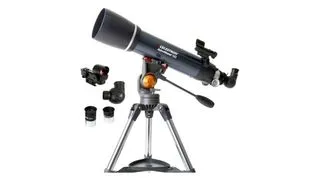 Celestron AstroMaster 102AZ and accessories on a white background
Celestron AstroMaster 102AZ and accessories on a white background
Refractors are commonly supplied with a simple alt-azimuth mount, allowing easy up and down, and side to side movement, typical for many beginner amateur telescopes. (Image credit: Amazon)
How does a refractor amateur telescope work?
Refractors bend (refract) light through lenses to form an image of an astronomical target. Known for their ease of setup and low maintenance, they are well-suited for planetary and lunar observation. A refractor features a main objective lens at one end and a star diagonal with an eyepiece at the other. This intuitive design makes them popular as a first amateur telescope. They are usually mounted on a simple alt-azimuth mount for basic directional control. Their manufacturing simplicity (for basic models) often translates to a lower purchase price.
A drawback is that the cost of refractor amateur telescopes increases significantly with aperture size. Basic refractors are sometimes replicated by non-reputable vendors, so caution is advised during purchase. Refractors excel at providing highly magnified, high-contrast images, making them ideal for solar system targets like the moon and planets. A good amateur telescope refractor usually has an aperture of 2 inches (60mm) or more; 3 to 4-inch (80-90mm) models are better for a larger aperture.
Chromatic aberration, or color fringing, is a common issue where bright objects show a colored halo because the lens doesn’t focus all light wavelengths to a single point. Achromatic and APOchromatic (Extra Dispersion – ED) designs mitigate this. Achromatic refractors are more affordable but may still show some fringing. Apochromatic refractors, using special glass, offer near-perfect color correction but are considerably more expensive, representing a significant step up for amateur telescopes. Even with some fringing, the viewing experience is generally good, especially for those starting out. Note that some high-end apochromats may require purchasing a tripod separately.
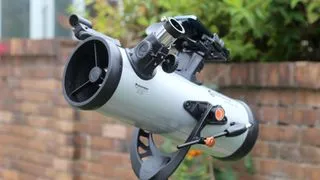 Celestron StarSense Explorer LT 114AZ amateur telescope against a brick wall
Celestron StarSense Explorer LT 114AZ amateur telescope against a brick wall
Reflector amateur telescopes are excellent for low-magnification targets such as galaxies and nebulae. (Image credit: Jamie Carter)
How does a reflector amateur telescope work?
Two popular types of reflector amateur telescopes are the Newtonian and the Dobsonian. Both use mirrors to reflect light and create an image. A Newtonian features a curved primary mirror at the tube’s base that reflects light back up to a smaller, flat secondary mirror near the front, which then directs the light at a 45-degree angle to the eyepiece.
Newtonian amateur telescopes can be found on alt-azimuth mounts but are more often paired with equatorial mounts, allowing them to track the sky’s rotation, which is beneficial for astrophotography and longer observations. They are favored in the amateur astronomy community for their versatility and the ability to get a large aperture for less money compared to refractors, offering significant value for money.
Reflector amateur telescopes, particularly Newtonians, require some maintenance, specifically periodic alignment (collimation) of the mirrors and occasional cleaning. Mirrors can also tarnish, so choosing a model with a protective coating is beneficial. Setting up and using an equatorial mount can be challenging for beginners, which is where the Dobsonian excels. Dobsonians use a simple alt-azimuth mount, making them very easy to maneuver. For those needing assistance with object location, computerized GoTo Dobsonians and Newtonians are available, though at a higher cost. Whatever type you choose, reflector amateur telescopes are excellent for observing low-magnification, wide-field targets like galaxies and nebulae.
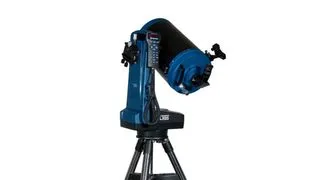 Meade Instruments LX65 GoTo amateur telescope product photo
Meade Instruments LX65 GoTo amateur telescope product photo
The compact optical tube design in catadioptric amateur telescopes allows for high magnifications within a smaller form factor. (Image credit: B&H Photo)
How does a catadioptric amateur telescope work?
Ideal for astrophotography, catadioptric amateur telescopes combine features of both refractors and reflectors to offer high-definition views of a wide array of astronomical targets. They are known for their lightweight design and portability, and their sealed optics require minimal maintenance. The primary drawback for many amateur astronomers is their typically higher price point compared to basic refractors or reflectors, though affordable options can be found with careful shopping.
Catadioptric amateur telescopes use both lenses and mirrors. Light passes through a lens (corrector plate) which helps reduce optical aberrations, then reflects off a curved primary mirror to a secondary mirror, and finally reaches the eyepiece. The two main types are Schmidt-Cassegrains and Maksutov-Cassegrains. The Maksutov-Cassegrain (often called ‘Mak’) specifically corrects for coma, an aberration that distorts star shapes at the edge of the field, using a spherical mirror and a meniscus lens.
Maksutovs are also effective at correcting chromatic aberration, providing clean views without false color fringes. Their compact design is well-suited for high-magnification viewing of planets, the moon, and double stars. Both Schmidt-Cassegrains and Maksutov-Cassegrains are frequently available with GoTo systems, aiding amateur astronomers in navigating the sky.
The Schmidt-Cassegrain offers capabilities similar to the Maksutov, suitable for general observation of planets and stars. Its field of view can be expanded with corrector lenses, increasing the range of targets observable with this type of amateur telescope.
 Celestron Starsense explorer 8-inch dobsonian red dot finderscope on an amateur telescope
Celestron Starsense explorer 8-inch dobsonian red dot finderscope on an amateur telescope
A finderscope attached to an amateur telescope, pictured here on the Celestron Starsense Explorer 8-inch Dobsonian. (Image credit: Jamie Carter)
What is a finderscope for amateur telescopes?
A finderscope is a small, low-magnification telescope mounted parallel to your main amateur telescope tube. Its purpose is to help you locate your desired celestial object easily. Your main telescope has a narrow field of view, showing only a small part of the sky. A finderscope, with its much wider field of view, makes pointing your main telescope much easier. You center the target in the finderscope, usually using crosshairs or a dot, and the object will then be centered in your main telescope’s eyepiece.
Many amateur telescopes include a finderscope. If purchasing one separately, you’ll encounter straight-through and right-angle views. Newtonian reflectors typically use right-angle finders due to their eyepiece position. Refractors and catadioptrics often pair better with straight-through finders. Some finderscopes offer magnification, and higher magnification with a narrower field can be beneficial for pinpoint accuracy. The terms ‘inverted’ or ‘erect image’ refer to whether the image is shown right-side up and corrected left-to-right. Erect image finders are less disorienting, especially for beginners using amateur telescopes, compared to those that show an upside-down or reversed view.
What does aperture, magnification and focal length mean for amateur telescopes?
Understanding these terms is key to choosing and using amateur telescopes effectively. Aperture refers to the diameter of the telescope’s main lens or primary mirror – it’s the light-gathering element. A larger aperture collects more light, revealing fainter objects and finer details. For example, a 200mm aperture gathers four times more light than a 100mm telescope.
This directly impacts how much you can see, a crucial factor for amateur telescopes. Under ideal conditions, a 100mm telescope can reveal stars down to magnitude +11.8, while a 200mm can show stars down to +13.3. Resolution also improves with aperture; a 100mm telescope resolves a 3km lunar crater, while a 200mm resolves a 1.5km crater. Resolution is limited by optical quality and atmospheric stability.
Magnification is determined by the telescope’s focal length (distance from the objective/mirror to the focus point) and the eyepiece’s focal length. Magnification = Telescope Focal Length / Eyepiece Focal Length. A telescope with an 800mm focal length used with a 10mm eyepiece provides 80x magnification (800 / 10 = 80). The useful magnification range depends on aperture, telescope focal length, and eyepiece focal length. Too low magnification can waste light if the eyepiece’s ‘exit pupil’ (calculated by dividing aperture by magnification) is larger than your eye’s dilated pupil (average ~7mm in dark). An exit pupil of 7mm or smaller ensures all gathered light enters the eye, important for faint objects.
High magnification reduces object brightness and amplifies atmospheric turbulence, making it practical only under good viewing conditions and with driven (motorized) amateur telescopes that track objects. As a guideline, the highest useful magnification is roughly double the telescope’s aperture in millimeters (e.g., 200x on a 100mm, 400x on a 200mm).
 Celestron Starsense Explorer 8-inch Dobsonian close up view of eyepiece
Celestron Starsense Explorer 8-inch Dobsonian close up view of eyepiece
Amateur telescope eyepieces can be swapped to change magnification. Pictured is the eyepiece from the Celestron Starsense Explorer 8-inch Dobsonian. (Image credit: Jamie Carter)
Magnification: How do amateur telescope eyepieces work?
Eyepieces magnify the light focused by the telescope’s primary mirror or objective lens. Each amateur telescope eyepiece has a specific focal length (in millimeters); shorter focal lengths provide higher magnification. Calculate magnification by dividing the telescope’s focal length by the eyepiece’s focal length. For example, a 1000mm focal length telescope (like a 100mm f/10 refractor or a 200mm f/5 Newtonian) yields 100x magnification with a 10mm eyepiece.
While any amateur telescope can achieve high magnification with short focal length eyepieces, there’s a point where increased magnification degrades the image quality rather than improving it. Magnifying an object spreads the light over a larger area, reducing brightness. High magnification also makes atmospheric turbulence more apparent, limiting its usability to good seeing conditions. Additionally, high magnification is best with driven telescopes; otherwise, objects quickly drift out of view.
A good rule of thumb for amateur telescopes is that the highest useful magnification is roughly twice the telescope’s aperture in millimeters. Ideally, have at least three quality eyepieces providing low, medium, and high magnifications (e.g., 50x, 100x, and 200x). For a 100mm f/10 telescope, this might be 20mm, 10mm, and 5mm Plossl eyepieces. A 20mm eyepiece might offer a ~1-degree field of view, suitable for scanning deep skies. A 10mm eyepiece shows roughly the half-degree moon, and a 5mm eyepiece has a much narrower field, usable only when conditions permit.
How we test the best amateur telescopes
Our process for evaluating the best amateur telescopes ensures honest and informed recommendations. Each telescope undergoes thorough testing and observation to assess its performance across all aspects. We examine the build quality of the Optical Tube Assembly (OTA), noting the telescope type (refractor, reflector, catadioptric), its components, size, and lens clarity. This is crucial as some amateur telescopes require regular collimation and cleaning.
Accessories like eyepieces and mounts are assessed for functionality and quality. Alt-azimuth and equatorial mounts are tested for smooth movement, especially motorized ones. Star alignment difficulty is also evaluated, ranging from simple finderscope alignment to complex laser collimation. Considering that amateur telescopes are complex instruments, we consider the level of astronomical knowledge required for easy operation. Powerful, intricate models often demand frequent adjustments. We also evaluate portability – how suitable the amateur telescope is for travel to darker sites.
The most critical aspect is observational performance. We provide examples of target objects observed (moon, Jupiter, Messier objects) and honestly describe image quality, checking for aberrations and distortions common in amateur telescopes. We compare manufacturer claims against real-world use. Our team of seasoned stargazers and freelance reviewers, alongside expert astronomers like Dr. Gemma Lavender, ensures accurate and important information on using amateur telescopes.
